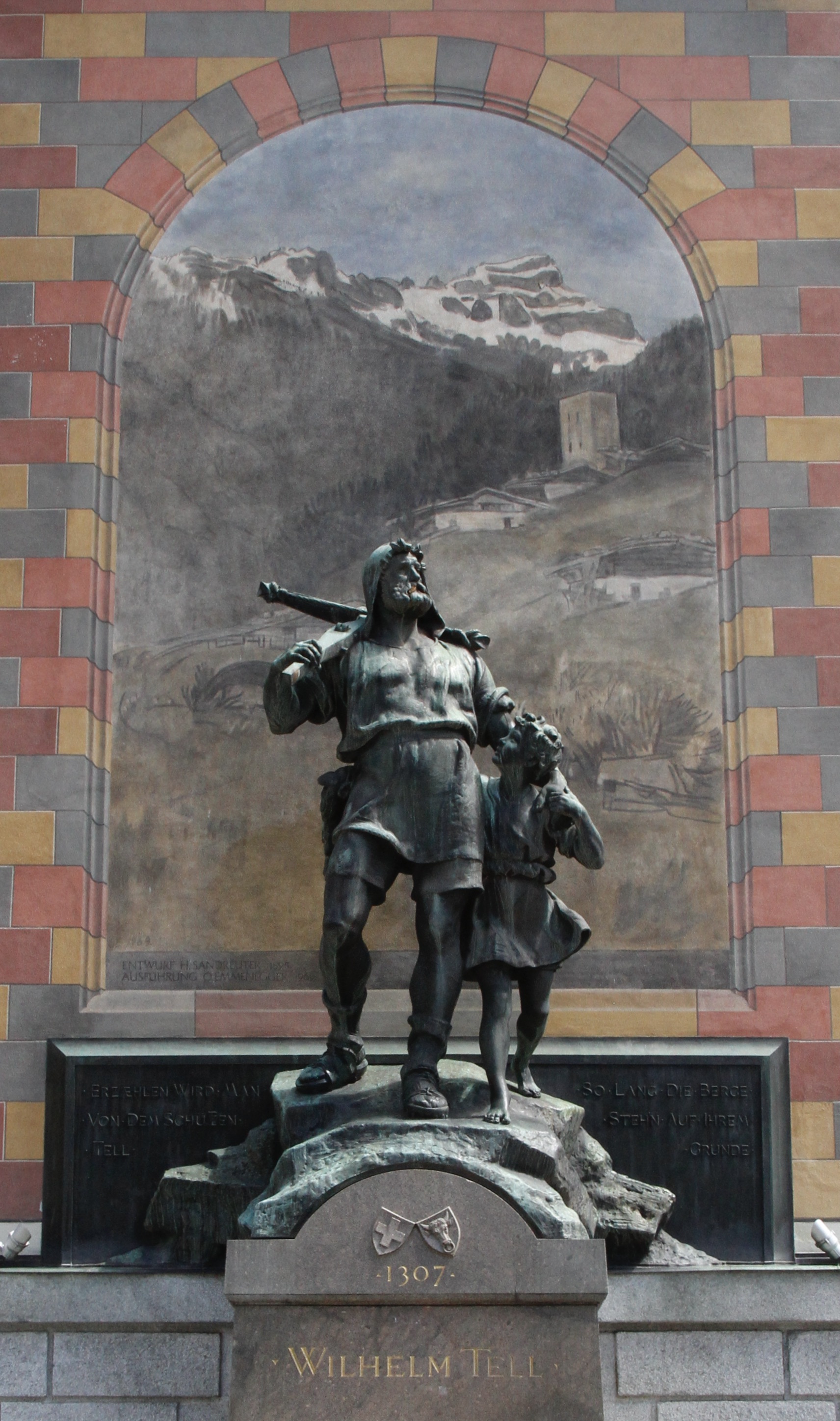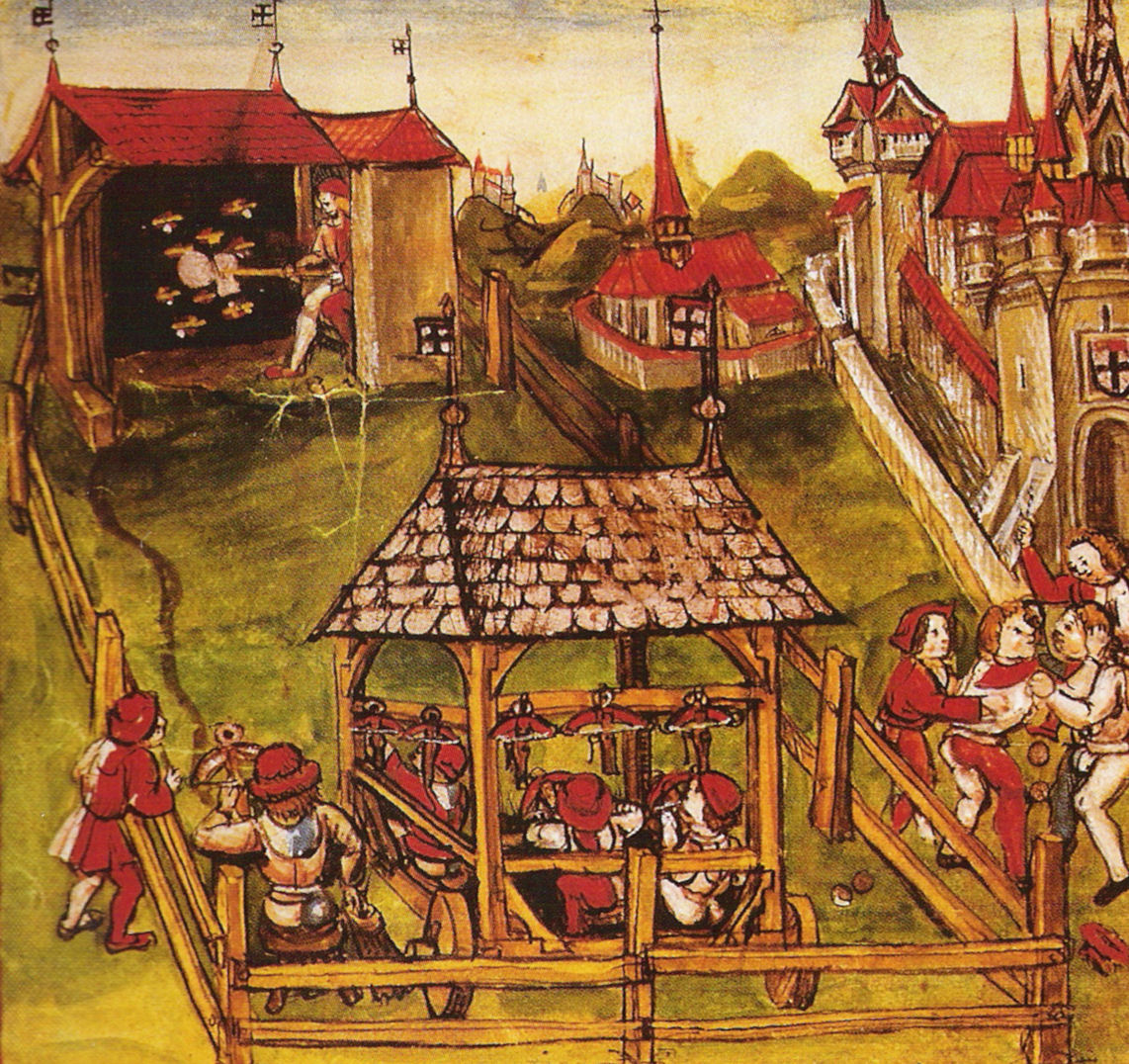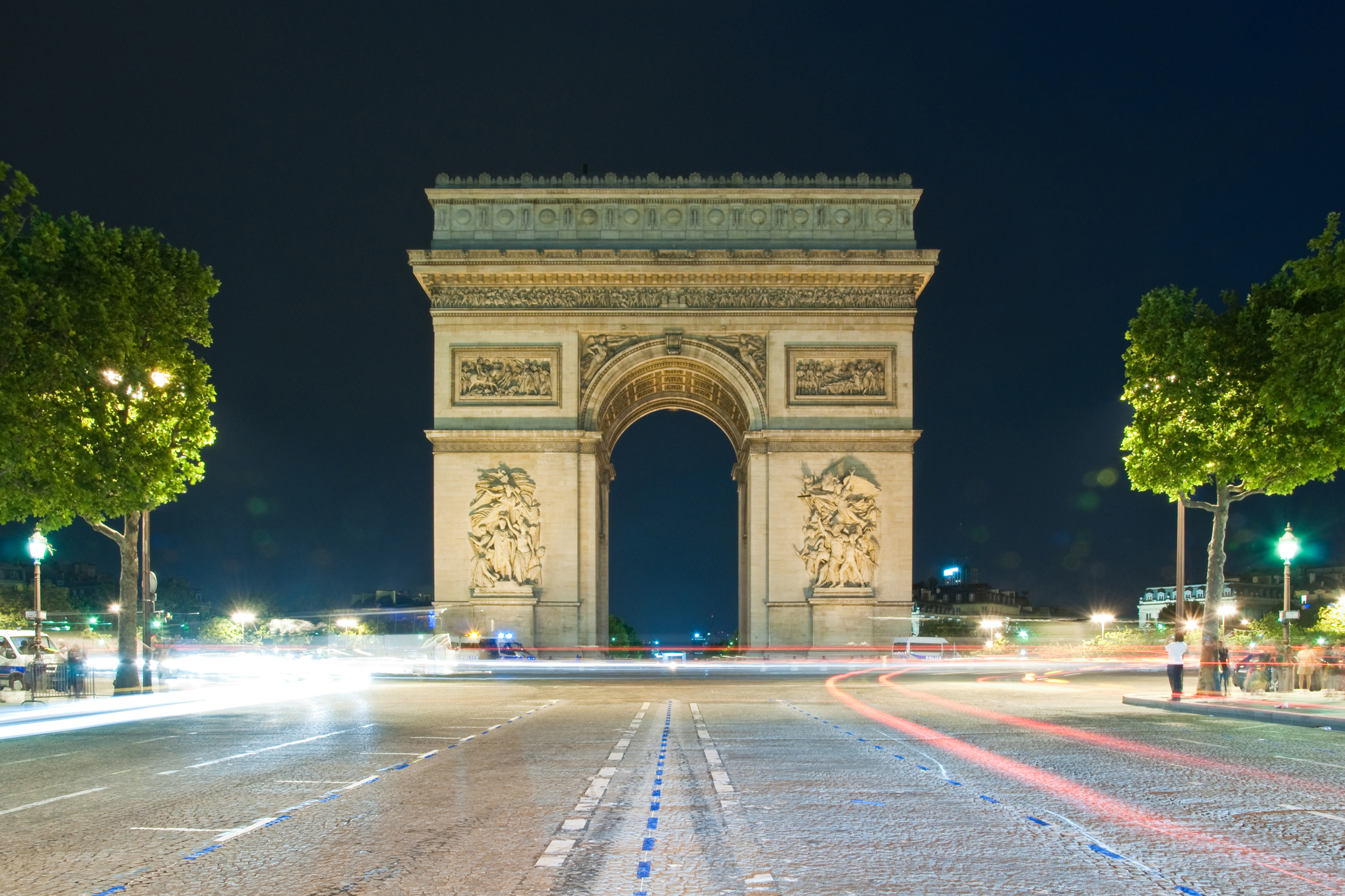|
Tell Monument
The 'Tell Monument' (german: Telldenkmal) is a memorial to William Tell in the market place of Altdorf, Canton of Uri, Switzerland. The bronze statue by sculptor Richard Kissling was inaugurated on August 28, 1895 at the foot of an old tower. It shows the Swiss national hero with his crossbow and accompanied by his son. At the base is the traditional date of Rütlischwur of 1307. Legendary Wilhelm Tell Wilhelm Tell is credited with having played a central role for the foundation of Switzerland. After Tell shot the Austria reeve Albrecht Gessler, a Swiss uprising against the Austrian rule began. When Tell refused to bow before a hat on a pole Gessler had erected in Altdorf, Tell was forced to either shoot an apple of his sons head or face death. Tell then shot an apple from his sons head with his crossbow. Acknowledging the feat Tell just achieved, Gessler questioned why Tell had prepared a second to which Tell responded that in case he shot his own son with the first arrow ... [...More Info...] [...Related Items...] OR: [Wikipedia] [Google] [Baidu] |
William Tell
William Tell (german: Wilhelm Tell, ; french: Guillaume Tell; it, Guglielmo Tell; rm, Guglielm Tell) is a folk hero of Switzerland. According to the legend, Tell was an expert mountain climber and marksman with a crossbow who assassinated Albrecht Gessler, a tyrannical reeve of the Austrian dukes of the House of Habsburg positioned in Altdorf, in the canton of Uri. Tell's defiance and tyrannicide encouraged the population to open rebellion and a pact against the foreign rulers with neighbouring Schwyz and Unterwalden, marking the foundation of the Swiss Confederacy. Tell was considered the father of the Swiss Confederacy. Set in the early 14th century (traditional date 1307, during the rule of Albert of Habsburg), the first written records of the legend date to the latter part of the 15th century, when the Swiss Confederacy was gaining military and political influence. Tell is a central figure in Swiss national historiography, along with Arnold von Winkelried, the hero ... [...More Info...] [...Related Items...] OR: [Wikipedia] [Google] [Baidu] |
Lugano
Lugano (, , ; lmo, label=Ticinese dialect, Ticinese, Lugan ) is a city and municipality in Switzerland, part of the Lugano District in the canton of Ticino. It is the largest city of both Ticino and the Italian-speaking southern Switzerland. Lugano has a population () of , and an urban agglomeration of over 150,000. It is the List of cities in Switzerland, ninth largest Swiss city. The city lies on Lake Lugano, at its largest width, and, together with the adjacent town of Paradiso, Switzerland, Paradiso, occupies the entire bay of Lugano. The territory of the municipality encompasses a much larger region on both sides of the lake, with numerous isolated villages. The region of Lugano is surrounded by the Lugano Prealps, the latter extending on most of the Sottoceneri region, the southernmost part of Ticino and Switzerland. Both western and eastern parts of the municipality share an international border with Italy. Described as a market town since 984, Lugano was the object of con ... [...More Info...] [...Related Items...] OR: [Wikipedia] [Google] [Baidu] |
Wilhelm Tell Denkmal Altdorf Um 1900 , the Dutch national anthem
{{Disambiguation ...
Wilhelm may refer to: People and fictional characters * William Charles John Pitcher, costume designer known professionally as "Wilhelm" * Wilhelm (name), a list of people and fictional characters with the given name or surname Other uses * Mount Wilhelm, the highest mountain in Papua New Guinea * Wilhelm Archipelago, Antarctica * Wilhelm (crater), a lunar crater See also * Wilhelm scream, a stock sound effect * SS ''Kaiser Wilhelm II'', or USS ''Agamemnon'', a German steam ship * Wilhelmus "Wilhelmus van Nassouwe", usually known just as "Wilhelmus" ( nl, Het Wilhelmus, italic=no; ; English translation: "The William"), is the national anthem of both the Netherlands and the Kingdom of the Netherlands. It dates back to at least 157 ... [...More Info...] [...Related Items...] OR: [Wikipedia] [Google] [Baidu] |
Federal Council (Switzerland)
The Federal Council (german: Bundesrat; french: Conseil fédéral; it, Consiglio federale; rm, Cussegl federal) is the executive body of the federal government of the Swiss Confederation and serves as the collective head of state and government of Switzerland. It meets in the west wing of the Federal Palace in Bern. While the entire Federal Council is responsible for leading the federal administration of Switzerland, each Councillor heads one of the seven federal executive departments. The position of President of the Swiss Confederation rotates among the seven Councillors on a yearly basis, with one year's Vice President of Switzerland becoming the next year's President of Switzerland. Ignazio Cassis has been the incumbent officeholder since 1 January 2022. An election of the entire Federal Council occurs every four years; voting is restricted to the 246 members of the Federal Assembly of Switzerland. There is no mechanism for recall after election. Incumbents are almos ... [...More Info...] [...Related Items...] OR: [Wikipedia] [Google] [Baidu] |
Lausanne
Lausanne ( , , , ) ; it, Losanna; rm, Losanna. is the capital and largest city of the Swiss French speaking canton of Vaud. It is a hilly city situated on the shores of Lake Geneva, about halfway between the Jura Mountains and the Alps, and facing the French town of Évian-les-Bains across the lake. Lausanne is located northeast of Geneva, the nearest major city. The municipality of Lausanne has a population of about 140,000, making it the List of cities in Switzerland, fourth largest city in Switzerland after Basel, Geneva, and Zurich, with the entire agglomeration area having about 420,000 inhabitants (as of January 2019). The metropolitan area of Lausanne-Geneva (including Vevey-Montreux, Yverdon-les-Bains, Valais and foreign parts), commonly designated as ''Lake Geneva region, Arc lémanique'' was over 1.3 million inhabitants in 2017 and is the fastest growing in Switzerland. Initially a Celtic and Roman settlement on the shores of the lake, Lausanne became a town at ... [...More Info...] [...Related Items...] OR: [Wikipedia] [Google] [Baidu] |
Ancient Greek Sculpture
The sculpture of ancient Greece is the main surviving type of fine ancient Greek art as, with the exception of painted ancient Greek pottery, almost no ancient Greek painting survives. Modern scholarship identifies three major stages in monumental sculpture in bronze and stone: the Archaic (from about 650 to 480 BC), Classical (480–323) and Hellenistic. At all periods there were great numbers of Greek terracotta figurines and small sculptures in metal and other materials. The Greeks decided very early on that the human form was the most important subject for artistic endeavour. Seeing their gods as having human form, there was little distinction between the sacred and the secular in art—the human body was both secular and sacred. A male nude of Apollo or Heracles had only slight differences in treatment to one of that year's Olympic boxing champion. The statue, originally single but by the Hellenistic period often in groups was the dominant form, though reliefs, often ... [...More Info...] [...Related Items...] OR: [Wikipedia] [Google] [Baidu] |
Heinrich Max Imhof
Heinrich Max Imhof (14 May 1795 or 1798, Bürglen - 4 May 1869, Rome) was a Swiss sculptor, in the Classical style. Max may be short for either "Maximilian" or "Maximus". Biography He was born to a family of tenant farmers and grew up in simple circumstances, but displayed an early talent for drawing. In 1811, he convinced his parents to let him serve an apprenticeship with the wood sculptor, , in Kerns. He made his first professional wood carvings at the parish church there, in 1814. Four years later the travel writer, Johann Gottfried Ebel, became aware of his carvings and brought him to Zürich, where he worked as a freelance sculptor, making portrait reliefs. His clients included the Prussian Crown Prince, Friedrich Wilhelm. In 1820 Ebel provided the means for him to continue his studies in Stuttgart with Johann Heinrich von Dannecker, then financed his first study trip to Rome. There, he familiarized himself with Classical styles, in the workshops of the Danish scul ... [...More Info...] [...Related Items...] OR: [Wikipedia] [Google] [Baidu] |
Endurance
Endurance (also related to sufferance, resilience, constitution, fortitude, and hardiness) is the ability of an organism to exert itself and remain active for a long period of time, as well as its ability to resist, withstand, recover from and have immunity to trauma, wounds or fatigue. It is usually used in aerobic or anaerobic exercise. The definition of 'long' varies according to the type of exertion – minutes for high intensity anaerobic exercise, hours or days for low intensity aerobic exercise. Training for endurance can reduce the ability to exert endurance strength unless an individual also undertakes resistance training to counteract this effect. When a person is able to accomplish or withstand a higher amount of effort than their original capabilities their endurance is increasing which to many personnel indicates progress. In looking to improve one's endurance they may slowly increase the amount of repetitions or time spent, if higher repetitions are taken ... [...More Info...] [...Related Items...] OR: [Wikipedia] [Google] [Baidu] |
Caricature
A caricature is a rendered image showing the features of its subject in a simplified or exaggerated way through sketching, pencil strokes, or other artistic drawings (compare to: cartoon). Caricatures can be either insulting or complimentary, and can serve a political purpose, be drawn solely for entertainment, or for a combination of both. Caricatures of politicians are commonly used in editorial cartoons, while caricatures of movie stars are often found in entertainment magazines. In literature, a ''caricature'' is a distorted representation of a person in a way that exaggerates some characteristics and oversimplifies others. Etymology The term is derived for the Italian ''caricare''—to charge or load. An early definition occurs in the English doctor Thomas Browne's ''Christian Morals'', published posthumously in 1716. with the footnote: Thus, the word "caricature" essentially means a "loaded portrait". Until the mid 19th century, it was commonly and mistakenly beli ... [...More Info...] [...Related Items...] OR: [Wikipedia] [Google] [Baidu] |
Gypcrust
Gypcrete or gypcrust is a hardened layer of soil, consisting of around 95% gypsum (calcium sulfate). Gypcrust is an arid zone duricrust. It can also occur in a semiarid climate in a basin with internal drainage, and is initially developed in a playa as an evaporate. Gypcrete is the arid climate's equivalent to calcrete, which is a duricrust that is unable to generate in very arid climates. Composition Gypcrust horizons can be up to thick with a 75-97% gypsum (CaSO4∙2H2O) content. The majority of gypsum-rich layers occur where the average annual rainfall is less than 250 mm because gypsum is moderately soluble (c. 2.6 g−1 at 25 °C) and is normally leached out under higher rainfall conditions. Gypsum cements are rarely, if ever, as strong as calcretes or silcretes. Formation Gypcrust forms in a manner similar to that of caliche, which is composed of calcium carbonate. The development of gypcrust has 3 main stages. The first stage is primary crystallization ... [...More Info...] [...Related Items...] OR: [Wikipedia] [Google] [Baidu] |
Eidgenössisches Schützenfest
''Eidgenössische Schützenfeste'' (singular ''Eidgenössisches Schützenfest'', french: Fête Fédérale de Tir, it, Festa tiro federale ) are the Swiss federal shooting competitions organized by the ''Schweizerischer Schützenverein'' since 1824. History Organised shooting societies are recorded in Swiss cities from the 14th century, at the time mostly using crossbows. The first blackpowder shooting societies are formed in the later 15th century; Geneva in 1474 had three separate societies for crossbow, longbow and arquebus shooters. ''Schützenfeste'' contributed significantly to the coherence between the individual cantons. After the end of the Old Zürich War (1450), the federal shooting festival in Sursee (1452) contributed to the renewal of cohesion between the members of the confederacy. Federal events became popular in the wake of the Sursee festival, with events in Feldkirch (1455), Strasbourg (1456) and Constance (1458). The shooting societies petitioned the Tagsa ... [...More Info...] [...Related Items...] OR: [Wikipedia] [Google] [Baidu] |
Triumphal Arch
A triumphal arch is a free-standing monumental structure in the shape of an archway with one or more arched passageways, often designed to span a road. In its simplest form a triumphal arch consists of two massive piers connected by an arch, crowned with a flat entablature or attic on which a statue might be mounted or which bears commemorative inscriptions. The main structure is often decorated with carvings, sculpted reliefs, and dedications. More elaborate triumphal arches may have multiple archways. Triumphal arches are one of the most influential and distinctive types of architecture associated with ancient Rome. Thought to have been invented by the Romans, the Roman triumphal arch was used to commemorate victorious generals or significant public events such as the founding of new colonies, the construction of a road or bridge, the death of a member of the imperial family or the ascension of a new emperor. The survival of great Roman triumphal arches such as the Arch of Ti ... [...More Info...] [...Related Items...] OR: [Wikipedia] [Google] [Baidu] |



.jpg)



